I know my answer won't be liked by many but please consider the points outlined here before thumbing down.
Anything easily machine readable will be easily machine readable by the spammers. Even though their actions seem stupid to us, they're not stupid people. They're innovative and resourceful. They do not just use bots to harvest e-mails, they have a plethora of methods at their disposal and in addition to that, they simply pay for good fresh lists of e-mails. What it means is, that they got thousands of black-hat hackers worldwide to execute their jobs. People ready to code malware that scrape the screens of other peoples' browsers which eventually renders any method you're trying to achieve useless. This thread has already been read by 10+ such people and they're laughing at us. Some of them may be even bored to tears to find out we cannot put up a new challenge to them.
Keep in mind that you're not eventually trying to save your time but the time of others. Because of this, please consider spending some extra time here. There is no easy-to-execute magic bullet that would work. If you work in a company that publishes 100 peoples' e-mails on the site and you can reduce 1 spam e-mail per day per person, we're talking about 36500 spam emails a year. If deleting such e-mail takes 5 seconds on average, we're talking about 50 working hours yearly. Not to mention the reduced amount of annoyance. So, why not spend a few hours on this?
It's not only you and the people who receive the e-mail that consider time an asset. Therefore, you must find a way to obfuscate the e-mail addresses in such way, that it doesn't pay off to crack it. If you use some widely used method to obfuscate the e-mails, it really pays off to crack it. Since as an result, the cracker will get their hands on thousands, if not tens or hundreds of thousands of fresh e-mails. And for them, they will get money.
So, go ahead and code your own method. This is a rare case where reinventing the wheel really pays off. Use a method that is not machine readable and one which will preferably require some user interaction without sacrificing the user experience.
I spent some 20 minutes to code off an example of what I mean. In the example, I used KnockoutJS simply because I like it and I know you won't probably use it yourself. But it's irrelevant anyway. It's a custom solution which is not widely used. Cracking it won't pose a reward for doing it since the method of doing it would only work on a single page in the vast internet.
Here's the fiddle: http://jsfiddle.net/hzaw6/
The below code is not meant to be an example of good code. But just a quick sample of code which is very hard for machine to figure out we even handle e-mails in here. And even if it could be done, it's not gonna pay off to execute in large scale.
And yes, I do know it doesn't work on IE = lte8 because of 'Unable to get property 'attributes' of undefined or null reference' but I simply don't care because it's just a demo of method, not actual implementation, and not intended to be used on production as it is. Feel free to code your own which is cooler, technically more solid etc..
Oh, and never ever ever name something mail or email in html or javascript. It's just way too easy to scrape the DOM and the window object for anything named mail or email and check if it contains something that matches an e-mail. This is why you don't want any variables ever that would contain e-mail in it's full form and this is also why you want user to interact with the page before you assign such variables. If your javascript object model contains any e-mail addresses on DOM ready state, you're exposing them to the spammers.
The HTML:
<div data-bind="foreach: contacts">
<div class="contact">
<div>
<h5 data-bind="text: firstName + ' ' + lastName + ' / ' + department"></h5>
<ul>
<li>Phone: <span data-bind="text: phone"></span></li>
<li><a href="#999" data-bind="click:$root.reveal">E-mail</a> <span data-bind="visible: $root.msgMeToThis() != ''"><input class="merged" data-bind="value: mPrefix" readonly="readonly" /><span data-bind="text: '@' + domain"></span></span></li>
</ul>
</div>
</div>
</div>
The JS
function ViewModel(){
var self = this;
self.contacts = ko.observableArray([
{ firstName:'John', mPrefix: 'john.doe', domain: 'domain.com', lastName: 'Doe', department: 'Sales', phone: '+358 12 345 6789' },
{ firstName:'Joe', mPrefix: 'joe.w', domain: 'wonder.com', lastName: 'Wonder', department: 'Time wasting', phone: '+358 98 765 4321' },
{ firstName:'Mike', mPrefix: 'yo', domain: 'rappin.com', lastName: 'Rophone', department: 'Audio', phone: '+358 11 222 3333' }
]);
self.msgMeToThis = ko.observable('');
self.reveal = function(m, e){
var name = e.target.attributes.href.value;
name = name.replace('#', '');
self.msgMeToThis(name);
};
}
var viewModel = new ViewModel();
ko.applyBindings(viewModel);

 and the image alt will be alt="@" so the bot will find an image and any human will see it as a normal address so if he copy it he will copy the email and the job is don
so the code will be
and the image alt will be alt="@" so the bot will find an image and any human will see it as a normal address so if he copy it he will copy the email and the job is don
so the code will be